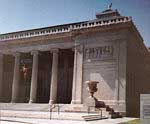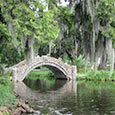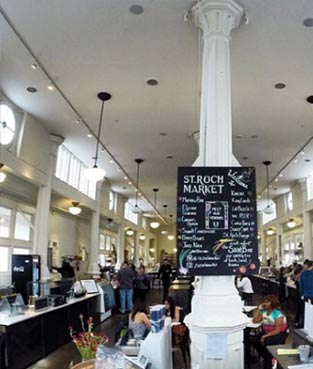New Orleans City Park
Established on a tract of land donated to the City of New Orleans by John McDonogh, and formerly the site of the Allard Plantation, is another of the crown jewels of New Orleans. It is City Park. Now a mile wide and three miles long (1,500 acres), it is bounded by City Park Avenue to the south, Robert E. Lee Blvd. to the north, Wisner Blvd. to the east, and Marconi Drive to the west.
A New Orleans recreation site for well over a century, City Park has more to offer than most widely advertised resorts, yet access to the park and its beauty is free. For those attractions that do require an admission charge, the fees are just a couple of dollars, well below the $10 to $15 admission fees that we often see elsewhere.
The Lagoons

 Most striking of the City Park features are the lagoons, populated by Cypress Trees and Live Oaks. The lagoons are all that remains of Bayou Metairie, and is home today for ducks, geese and swans. Visitors to the park can rent small boats, and enjoy an afternoon navigating the lagoons in the shade of the Oak and Cypress canopy.
Most striking of the City Park features are the lagoons, populated by Cypress Trees and Live Oaks. The lagoons are all that remains of Bayou Metairie, and is home today for ducks, geese and swans. Visitors to the park can rent small boats, and enjoy an afternoon navigating the lagoons in the shade of the Oak and Cypress canopy.
The Live Oaks have a history of their own. Many are hundreds of years old, and have a circumference of 30 to 40 feet! The Spanish Moss draped limbs of these magnificent oak trees reach out and gracefully touch the ground, providing a never ending source of amusement for children who like to climb. In the nineteen century, many disputes were settled under the oaks. "Dueling Oak" still stands, as does "Suicide Oak" and "McDonogh Oak".
Fine Art
At the main entrance to City Park (where Esplanade Avenue crosses Bayou St. John), you are greeted by a statue of General P. G. T. Beauregard. This marks the beginning of City Park's Lelong Avenue, which leads to the front of the New Orleans Museum of Art. The museum has hosted such exhibits as the Treasures of King Tut, paintings of the Armand Hammer Collection, the Fabergé Eggs and the paintings of Claude Monet. These exhibits had visitors standing in lines blocks long. Also impressive is its permanent art collection.
Sports
For sports lovers, fall weekends have non-stop prep football games at Tad Gormley Stadium, a 25,600 seat facility with a 400 meter internationally marked polyurethane track, and a synthetic grass turf football and soccer field. City Park also has another smaller stadium, Pan American Stadium, built in 1973.
If you prefer golf, there are four eighteen hole golf courses located in City Park. The courses are augmented by electric carts, individual and group lessons by PGA professionals, club rentals, a fully stocked pro shop and Colonial-style Clubhouse restaurant.
Centrally located in the park are 36 tennis courts (21 hardcourts and 15 clay courts), all lighted for night-time play. It is one of the largest tennis complexes in the South.
Picnics, Recreation and Amusement

Across from the tennis courts are the Popp Bandstand, built in 1917, and the Peristyle, built in 1907, both available for picnics, parties or special events. Also located there is the Casino Building, built in 1913 in a Spanish Mission-style. In 2012, the Casino Building became a Morning Call location. Morning Call is a popular beignets and cafe au lait stop for locals and visitors to the city. Surrounding these structures are play structures for the children and boat rentals on the lagoons.
On the opposite side of the tennis courts are picnic areas and children's amusements. For the smaller children, there is Storyland. It is a fairy tale theme park featuring 26 larger than life storybook exhibits for kids to climb in or on, and was created by one of New Orleans finest Mardi Gras float makers - Blaine Kern, Jr.
For children slightly older (and the younger ones, too) there is the William A. Hines Carousel Gardens, which has amusement rides such as a mini roller-coaster (the Lady Bug ride), bumper cars, a miniature train that provides a 15 minute ride through the southwestern quarter of the park, to Bayou St. John, and back and many more fun and exciting rides. The jewel of the gardens, though, is the beautifully restored antique wooden carousel (known in these parts as "the flying horses"), which was build in 1906.
Botanical Gardens
To list all of the features and attractions of City Park would make this feature longer than what would be practical, but there is one more worth mentioning. That is City Park's New Orleans Botanical Gardens. It is the only botanical garden in Louisiana, and contains about 2,000 varieties of flowers and plants. Recently added was the Pavilion of the Two Sisters, modeled after a traditional European orangery.



